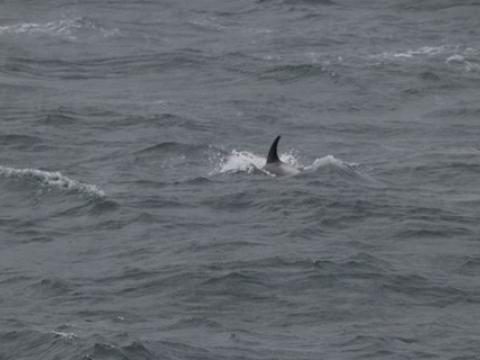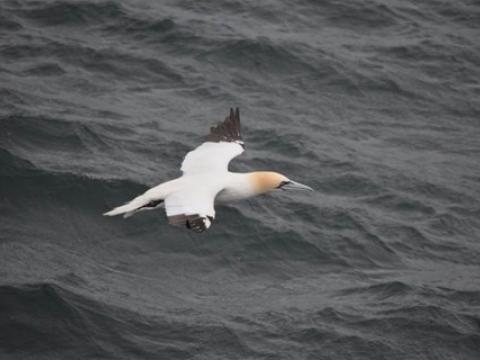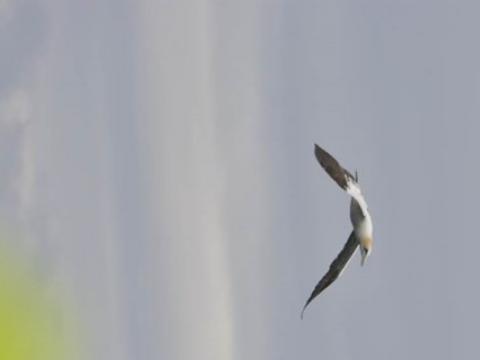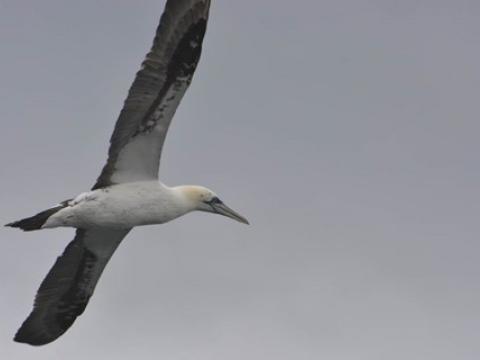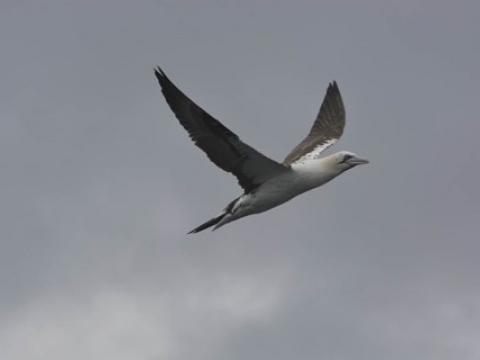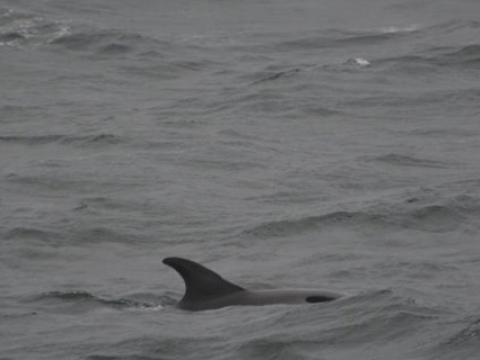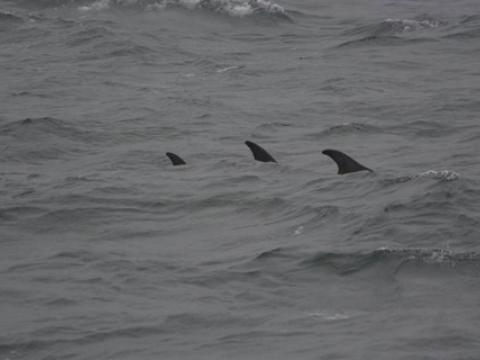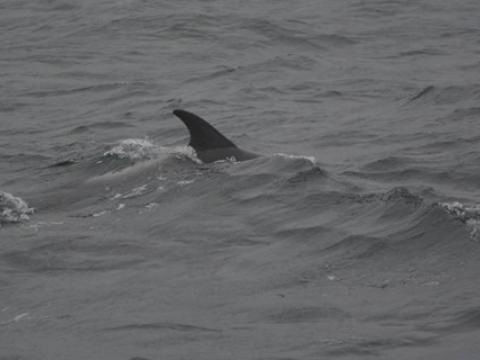Tour at 20:30
Report from Elding: We went out for the midnight sun tour but the sky was completely covered with clouds but somehow some sunlight fell on Mount Esja and beside it was a round spot of a part of a rainbow visible. We left the harbour with the wind at our back heading into the rain which became intenser during the trip. That´s why we don´t have pictures unfortunately, to prove our great sighting success. We started with a short glimpse at a fin of a Minke Whale disappearing in the waves and we kept on searching as suddenly at least 4 White-Beaked Dolphins came towards us. They came straight into our bow wave riding a bit before they started to change their directions frequently and diving longer. That´s how we lost them finally out of sight but before we had very good observations. Close, under water, synchronous swimming and frequent surfacing as some descriptions of this sighting. We continued southwards as we have been informed that the waves further out were too big and uncomfortable. Our visibility was shrinking as we entered some low rain clouds but even tough we came across a big blow and a body emerging partly out of the water. We have been so lucky to find among this difficult conditions a lunge feeding Humpback Whale! First we stayed at a save distance of over 150 m but with the rain and the wind in the eyes we didn´t see much more then a bushy, dense blow and a tiny bit of back from behind. We approached very carefully and the whale did the rest until he was feeding close by sometimes 20 sometimes 50 m away like we would not be around. We saw its open mouth breaking through the surface and once we saw in its upper jaw and his brown baleens. He was quickly changing directions and sometimes splashing while surfacing with some seabird around joining the feast. Once he spread out his winglike long flippers as he arched diving down. Amazing view at a probably juvenile Humpback Whale, which even made the musician stop their entertaining program and was delighting all of us.
- Carine Zimmermann
Tour at 17:00
Report from Hafsúlan: Since we had had bad sightings on the earlier tours, we decided to head into a different area this afternoon. We sailed south along the Reykjanes peninsula. After about half an hour, we got a distress call from the coast guard asking us to help look for a paraglider that had supposedly gone into the water close by. Of course, we obliged and helped look. There were lots of rescue boats that came into the area and the coast guards helicopter flew low over us several times. All the passengers were very understanding and cooperative and stood outside scanning the water surface. We are very thankful for that. The distress call later turned out to be a prank. We sailed around for the rest of the tour, looking for some whales but were not successful. We got to see some puffins, some arctic terns and one or two northern gannets but that was it. Quite disappointing. On the way back, almost all of our passengers came to get their complimentary tickets which are good for another two years. Better luck next time, hope to see you soon!
-Arnór Tumi
Tour at 14:00
Report from Elding: The weather forecast was announcing that the wind should calm down and as we headed out it felt better than in the morning, but probably we just had the way back more in mind when we were facing the wind and waves. This time it was raining on the way out but it got less rainy on the way back. The tour started similar than the 10:00 trip with a lot of birds and reports from other boats of cetacean sightings without anything showing up. We went on ourselves, finding 2 plunge feeding Northern Gannets among more of them. One was a brown spotted juvenile while the rest had their white "dresses" with the black sleeves and the yellow neck collar. As we went on searching we spotted our first Minke Whale which appeared several times and then headed off, but it was not too bad leaving it behind knowing that there were White-Beaked Dolphins coming in our direction. We made half way to them as we saw them surfing in the waves. We turned around and followed them for a while before we had to start our journey back into wind and waves towards Reykjavik. On this way we saw a lot more birds but one funny thing was worth mentioning. A Puffin, a Fulmar and an Arctic Tern were using the wave and the wind as a start ramp to take off one after the other which looked great.
- Carine Zimmermann
Tour at 13:00
Report from Hafsúlan: The wind had picked up slightly this afternoon but conditions were good on our way out with the wind at our backs. As we sailed out we were met by plenty of birds which is always a good sign. We had been sailing for about 45 minutes when we saw a large flock of feeding sea birds and decided to investigate. Sailing towards the flock we saw a blow followed by the dorsal fin of a Minke whale! This individual was quite elusive though and we managed one or two looks at him before we headed further out. Twenty minutes onwards we spotted quite a few Gannets diving at the surface repeatedly. Excited, we headed towards them and as we got closer another minke surfaced right behind the flock. We saw him once more but he then swam off too, showing the same elusive behaviour as the first minke. On our way back from that sighting we spotted another large flock of feeding birds and just as we turned towards it a pod of White-beaked dolphins appeared! These were very calm at first surfacing slowly right in front of us allowing us a very good look at them. But they too were quite elusive and swam away pretty quickly. Then as we were almost back to the harbour we caught a glimpse of a few more dolphins and followed them around before we had to head back. Evasive animals in the bay today but we were very happy with the dolphins we got a look at.
-Ívar Elí
Tour at 10:00
Report from Elding: We had similar conditions as Hafsúlan as we went out a bit later than them. On the way back there was slight rain. As several whale watching vessels had been searching for cetaceans, we heard a lot of reports about minkes and dolphins but every time we got there, we just saw white capped waves. Instead we enjoyed bird watching as there were a lot of birds all around. Closeby and further away we saw flocks and scattered birds often in mixed groups of at least four different species. Also numerous Northern Gannets which we have been missing in the last weeks. Finally without help from other boats we had two short glimpses at one Minke Whale which appeared suddenly in front of the boat reasonably close. But it was quite easy for a minke in these wind and waves to disappear so the cetaceans have been the winners in our hide and seek game. As we really wanted to show our passengers what it looks and feels like to go whale watching we offered them the chance to come again. But it seemed like they had a good time bird watching and sailing in Faxaflói according to the final applause.
- Carine Zimmermann
Tour at 09:00
Report from Hafsúlan: This morning, quite a strong wind was blowing from the south east. We were greeted by lots of birds on our way out. When we spotted a flock of northern gannets diving and feeding, we decided to approach it. There seemed to be plenty of food in this area but nevertheless, no whale was spotted. We sailed further and saw a blow in the distance. When we got to the spot where it had been seen, again, no whale showed up. After we had gone even further, finally a minke whale was spotted that did show up a few times. It was difficult to see it as it brought only a small fraction of its body out of the water each time. On the way back, another minke whale was seen and it surfaced a few times in front of the boat before we had run out of time and had to head back to the harbour. Despite plenty of wild life and food in the bay today, we did not get the whale sightings that we were hoping for. The whales were there, they just were not showing themselves very well.
-Arnór Tumi
Birds seen on today's tours include: Northern gannets, puffins, fulmars, kittiwakes, arctic skuas, great skuas, lesser black-backed gulls, manx shearwaters, arctic terns and common guillemots.




